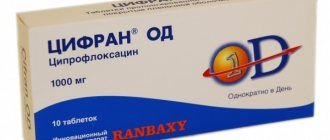Pharmacological properties of the drug Tsiprinol
A synthetic antibacterial drug with a broad spectrum of action from the fluoroquinolone group, which has a bactericidal effect. Tsiprinol acts both on microorganisms that are in the process of rapid growth, and on microorganisms that are in the resting phase. The antimicrobial activity of ciprofloxacin is due primarily to the presence of a cyclopropane ring at the 1st position, a fluorine ring at the 6th position, and a piperazine ring at the 7th position. The mechanism of action of ciprofloxacin in all phases of the cell cycle is due to the inhibition of subunit A of bacterial DNA gyrase, the enzyme responsible for bacterial DNA replication. The drug has a bactericidal effect on most gram-negative and some gram-positive microorganisms, including those resistant to other antibacterial drugs. are sensitive to ciprofloxacin in vitro : enterobacteria - E. coli , Shigella spp ., Salmonella spp ., Citrobacter spp ., Klebsiella spp ., Enterobacter spp ., Proteus mirabilis and vulgaris , Serratia marcescens, Hafnia alvei, Edwardsiella tarda, Providencia spp., Morganella morganii, Vibrio spp., Yersinia spp.; other gram-negative bacteria - Aeromonas spp., Plesiomonas shigelloides, Pasteurella multocida, Haemophilus spp., Campylobacter jejuni, Pseudomonas aeruginosa, Neisseria spp., Moraxella (Branhamella) catarrhalis ; some intracellular pathogens - Legionella pneumophila, Brucella spp., Chlamydia trachomatis, Listeria monocytogenes, Mycobacterium tuberculosis, Mycobacterium kansasii, Mycobacterium avium-intracellulare . in vitro sensitivity of the following gram-positive bacteria has been confirmed: Streptococcus spp. (S. pyogenes, S. agalactiae) ; Staphylococcus spp. (S. aureus, S. haemolyticus, S. hominis and S. saprophyticus ), Bacilus anthracis. The sensitivity of Enterococcus faecalis and Streptococcus pneumoniae is moderate. Bacteria from the group Corynebacterium spp., Bacteroides fragilis, Pseudomonas cepacia and maltophilia, Ureaplasma urealyticum, Clostridium difficile, Nocardia asteroides, Streptococcus faecalis and Treponema pallidum are resistant to ciprofloxacin. The manifestation of bacterial resistance usually indicates cross-resistance to all quinolones and is caused by a decrease in the permeability of the bacterial membrane to the drug, as well as a mutation in the A subunit of DNA gyrase, as a result of which the sensitivity of the bacterium to ciprofloxacin decreases (thus explaining the development of resistance in P. aeruginosa ). Resistance is most often detected in infections caused by Pseudomonas aeruginosa and certain strains of Staphylococcus aureus . In vitro , a synergistic effect has been established between ciprofloxacin and other antibiotics, such as imipenem, against P. aeruginosa , as well as mezlocillin, cefoxitin and clindamycin against B. fragilis , azlocillin against P. aeruginosa and ceftizoxime against P. aeruginosa and S. marcescens . The minimum inhibitory concentration (MIC90) of ciprofloxacin in vitro against the most sensitive bacteria to it is: for Enterobacter cloacae ( E. coli, Enterobacter spp., Citrobacter spp., Klebsiella spp., Proteus spp.) - 0.005–1 mg/l; Providencia spp . — 0.015–3.12 mg/l; Salmonella spp . — 0.015–0.25 mg/l; Serratia marcescens - 0.06–1 mg/l; Shigella spp . — 0.002–0.25 mg/l; Yersinia enterocolitica - 0.015–0.25 mg/l; Acinetobacter calcoaceticus - 0.25–1 mg/l; Neisseria gonorrhoeae - 0.002–0.03 mg/l; Neisseria meningitidis - 0.005–0.015 mg/l; Haemophilus influenzae - 0.007–0.05 mg/l; Pseudomonas aeruginosa - 0.12–4 mg/l; Pseudomonas spp. - 0.25–16 mg/l. The maximum concentration of the drug in the blood plasma is achieved 0.5–1.8 hours after oral administration. Food intake may alter the time to reach maximum plasma concentration but does not affect AUC. The volume of equilibrium distribution of ciprofloxacin after oral or intravenous administration is 1.74–5 l/kg body weight, which indicates good penetration of ciprofloxacin into tissues. The drug in therapeutic concentration accumulates in the bronchial mucosa, lung tissue, pleural exudate, liver and kidney parenchyma, bile, peritoneal fluid, genitals, prostate gland, bones, synovial tissue and fluid, skin and anterior ocular chamber. The highest concentration of ciprofloxacin is determined in the liver, gall bladder, bile, kidneys and prostate secretions. The concentration of the drug in the cerebrospinal fluid is in most cases lower than the concentration in the blood serum, but may increase with meningitis. Ciprofloxacin penetrates the placental barrier and enters breast milk. The drug is excreted from the body mainly through urine. After 48 hours, 30 to 50% of ciprofloxacin is excreted unchanged by the kidneys.
Indications for use of the drug Tsiprinol
Adults Uncomplicated and complicated infections caused by pathogens sensitive to ciprofloxacin:
- respiratory tract infections; treatment of pneumonia caused by Klebsiella spp., Enterobacter spp., Proteus spp, Escherichia coli, Pseudomonas aeruginosa, Haemophilus spp., Moraxella catarrhalis, Legionella and staphylococci;
- infections of the middle ear and paranasal sinuses;
- eye infections;
- infections of the abdominal organs, bacterial infections of the gastrointestinal tract, gall bladder and biliary tract, as well as peritonitis;
- kidney and urinary tract infections;
- infections of the pelvic organs (gonorrhea, adnexitis, prostatitis);
- skin and soft tissue infections;
- bone and joint infections;
- sepsis;
- prevention and treatment of infections in immunocompromised patients (including during treatment with immunosuppressants and with neutropenia);
- selective intestinal decontamination during treatment with immunosuppressants.
Children As a second or third line drug, it is used for the treatment of complicated urinary tract infections and pyelonephritis caused by E. coli in children aged 1–17 years, as well as for the treatment of exacerbations of respiratory system diseases caused by Pseudomonas aeruginosa in children with cystic fibrosis of the lungs aged 5–17 years. Adults and children Reduced risk of developing or progressing anthrax after aerogenic exposure to Bacillus anthracis .
Use of the drug Tsiprinol
The following doses are recommended: uncomplicated urinary tract infections and gonorrhea : 125 mg 2 times a day; complicated urinary tract infections and respiratory tract infections : 250–500 mg 2 times a day; severe infections, recurrent infections in patients with cystic fibrosis, infections of the abdominal organs, bones and joints caused by Pseudomonas or staphylococci, with peritonitis and septicemia, as well as with acute pneumonia caused by Streptococcus pneumoniae: the dose should be increased to 750 mg 2 times a day. The maximum daily dose is 1500 mg. When treating outpatients with pneumonia caused by Pneumococcus , ciprofloxacin should not be used as the first choice drug. The tablets should be swallowed without chewing and washed down with a small amount of liquid. The drug can be taken regardless of meals, however, taking it on an empty stomach accelerates the absorption of ciprofloxacin. If the patient’s condition does not allow taking tablets, it is recommended to carry out parenteral therapy with ciprofloxacin infusion solution, and after the patient’s condition improves, proceed to treatment with the tablet form of the drug. Elderly patients should be prescribed lower doses of ciprofloxacin based on the severity of the disease and creatinine clearance (for example, with a creatinine clearance of 30-50 ml/min, the recommended dose of ciprofloxacin is 250-500 mg every 12 hours). to children is permissible only after a careful assessment of the risk/benefit ratio due to the likelihood of developing side effects from the joints and/or periarticular tissues. Treatment of children in clinical trials was carried out only for the indications listed above. Clinical experience with ciprofloxacin in children for other indications is limited. The following dosage regimen should be followed:
- for complications of pulmonary cystic fibrosis caused by Pseudomonas aeruginosa , children aged 5–17 years are prescribed 20 mg/kg body weight orally 2 times a day. The maximum daily dose is 1500 mg. The duration of treatment is 10–14 days.
- for urinary tract infections or pyelonephritis, the dose should be 6–10 mg/kg body weight every 8 hours, but not more than the maximum dose of 400 mg, or 19–20 mg/kg body weight every 12 hours, but not more than the maximum dose of 750 mg.
To reduce the risk of occurrence or progression of anthrax after aerogenic contact with Bacillus anthracis , the dose for adults is 500 mg 2 times a day, for children - 15 mg/kg body weight 2 times a day. Do not exceed the maximum single dose of 500 mg and the maximum daily dose of 1000 mg. The drug should be taken immediately after infection is suspected or confirmed. The total duration of use of ciprofloxacin for pulmonary anthrax is 60 days. Renal dysfunction. With a creatinine clearance of 31–60 ml/min/1.73 m2 or a plasma creatinine concentration of 1.4–1.9 mg/100 ml, the maximum daily dose of ciprofloxacin for oral use should be 1000 mg. For creatinine clearance ≤30 ml/min/1.73 m2 or plasma creatinine concentration ≥2 mg/100 ml, the maximum daily oral dose of ciprofloxacin should be 500 mg. Renal dysfunction + hemodialysis. For creatinine clearance ≤30 ml/min/1.73 m2 or plasma creatinine concentration ≥2 mg/100 ml, the maximum daily oral dose of ciprofloxacin should be 500 mg; on days of hemodialysis, ciprofloxacin is taken after the procedure. Impaired renal function + peritoneal dialysis in outpatients: 1 tablet of 500 mg ciprofloxacin or 2 tablets of 250 mg. Liver dysfunction. There is no need for dose adjustment.
The duration of treatment depends on the severity of the disease, clinical course and results of bacteriological studies. It is recommended to continue treatment for at least 3 days after the temperature normalizes or clinical symptoms disappear. The duration of treatment for acute uncomplicated gonorrhea and cystitis is 1 day. For infections of the kidneys, urinary tract and abdominal organs, the duration of treatment reaches 7 days. For osteomyelitis, the course of therapy can be extended to 2 months. For other infections, the duration of treatment is usually 7–14 days. In immunocompromised patients, treatment is carried out throughout the entire period of neutropenia. For infections caused by streptococci and chlamydia, treatment should last at least 10 days.
Release form and composition
Dosage forms of Tsiprinol:
- Film-coated tablets: white, round or oval, with a notch (10 pieces in blisters, 1 blister in a cardboard box (250 and 500 mg tablets), 1 or 2 blisters (750 mg tablets));
- Concentrate for the preparation of infusion solution: transparent, colorless or slightly greenish-yellow, without mechanical inclusions (10 ml in ampoules, 5 ampoules in strip packs, 1 pack in a cardboard box);
- Solution for infusion: transparent, yellowish-greenish (50, 100 or 200 ml in bottles, 1 bottle in a cardboard box).
The active ingredient of the drug is ciprofloxacin (in the form of hydrochloride monohydrate). Its content:
- 1 tablet – 250, 500 or 750 mg;
- 1 ml of concentrate – 10 mg;
- 1 ml of solution – 2 mg.
Additional components of the tablets:
- Excipients: colloidal silicon dioxide anhydrous, povidone, magnesium stearate, microcrystalline cellulose, croscarmellose sodium, sodium carboxymethyl starch;
- Shell composition: propylene glycol, titanium dioxide (E171), talc, hypromellose.
Auxiliary components of the concentrate: disodium edetate, hydrochloric acid, lactic acid, water for injection.
Excipients of the solution: hydrochloric acid, sodium chloride, sodium lactate, water for injection.
Side effects of the drug Tsiprinol
Adverse reactions that may occur during the use of ciprofloxacin are classified into the following groups according to frequency:
- very often 1/10,
- often 1/100, ≤1/10,
- uncommon 1/1,000, ≤1/100,
- rarely 1/10,000, ≤1/1,000,
- very rare ≤1/10,000, including isolated cases.
The frequency of adverse reactions is classified according to organ systems. From the blood and lymphatic systems: infrequently - eosinophilia, leukopenia; rarely - anemia, granulocytopenia, leukocytosis, altered prothrombin levels, thrombocytopenia, thrombocytosis; very rare, including isolated cases - hemolytic anemia, pancytopenia, agranulocytosis, suppression of bone marrow function. From the nervous system: infrequently - headache, dizziness, fatigue, insomnia, agitation, confusion; rarely - hallucinations, perspiration, paresthesia, feeling of fear, nocturnal delirium, depression, tremor, convulsions, hypoesthesia; very rare, including isolated cases - lability of behavior, psychosis, increased intracranial pressure, ataxia, hyperesthesia, convulsive contractions. From the senses: infrequently - changes in taste and blurred vision; rarely - tinnitus, transient deafness (especially for high frequencies), visual impairment (diplopia, impaired color perception); very rarely, including isolated cases - loss of taste (usually transient). From the cardiovascular system: rarely - tachycardia, migraine, loss of consciousness, hot flushes and perspiration, peripheral edema; very rarely, including isolated cases - vasculitis. From the respiratory system: rarely - shortness of breath, laryngeal edema. From the gastrointestinal tract and hepatobiliary system: often - nausea, diarrhea; uncommon - vomiting, abdominal pain, flatulence, anorexia; rarely - cholestatic jaundice, pseudomembranous colitis; very rarely, including isolated cases - hepatitis (liver failure occurs exclusively, which is life-threatening). From the skin and subcutaneous tissues: often - rash; uncommon - itching, maculopapular rash, urticaria; rarely - photosensitivity reactions; very rare, including isolated cases - petechiae, papules, hemorrhagic cysts, crusts/scabs (as a result of vasculitis), erythema multiforme, erythema nodosum, Stevens-Johnson syndrome, toxic epidermal necrolysis (Lyell's syndrome). From the musculoskeletal system: infrequently - arthralgia; rarely - myalgia, joint swelling; very rare, including isolated cases - tendonitis (especially Achilles tendinitis), tendon rupture, myasthenia gravis. From the kidneys and urinary tract: rarely - interstitial nephritis, transient renal failure, hematuria and crystalluria. General disorders: infrequently - a feeling of weakness, prolonged use can lead to excessive growth of resistant bacteria and fungi (pseudomembranous colitis, candidiasis); rarely - hypersensitivity reactions, drug-induced increase in body temperature, anaphylactic reactions (facial swelling, angioedema, difficulty breathing, threat of shock), which may occur after the first dose, pain in the limbs, back and sternum; very rarely, including isolated cases - reactions similar to serum sickness, exacerbation of myasthenia gravis. Laboratory indicators: infrequently - increased activity of transaminases and alkaline phosphatase, increased levels of urea, creatinine and bilirubin in the blood plasma;
rarely - hyperglycemia, crystalluria and hematuria; very rare, including isolated cases - increased levels of amylase and lipase. If severe side effects occur (especially in the case of hypersensitivity reactions, pseudomembranous colitis, central nervous system disorders, hallucinations or tendon pain), treatment should be discontinued.
Special instructions for the use of the drug Tsiprinol
Since taking ciprofloxacin can cause severe reactions from the central nervous system (convulsions, increased intracranial pressure, psychosis, depression, dizziness, impaired consciousness, nervousness), this drug should be prescribed with particular caution to elderly patients with impaired central nervous system function (epilepsy, decreased seizure threshold , history of convulsions, decreased cerebral circulation, apoplexy, mental disorders), patients with severe liver damage or any type of renal failure (the patient's condition may worsen) or kidney failure and glucose-6-phosphate dehydrogenase deficiency (can cause hemolytic anemia). It is known that the very first use of this drug can cause severe allergic reactions. Alkaline urine may promote the formation of urinary stones, so alkalinization of urine should be avoided during treatment with ciprofloxacin. Before treatment and during the use of ciprofloxacin, the patient must have adequate fluid intake. Patients with renal failure should reduce the dose or increase the interval between doses of the drug, depending on the severity of the failure. Patients should avoid exposure to direct sunlight during treatment with ciprofloxacin, as phototoxic reactions may develop. During treatment with the drug, an increase in the resistance of microorganisms may be observed. In case of severe and prolonged diarrhea, which may be a manifestation of pseudomembranous colitis, treatment with the drug should be discontinued. There are reports of cases of inflammation or even rupture of the tendon during treatment with quinolones. Although the causal relationship with this particular group of drugs has not been clearly established, it is recommended to stop taking the drug if pain occurs along the tendon or at the first sign of tendinitis. During treatment and immediately after its discontinuation, the patient should avoid excessive physical activity. During treatment, patients should not drink alcohol. During pregnancy and breastfeeding. There is not enough data regarding the use of ciprofloxacin during pregnancy. During pregnancy and lactation, the use of the drug is allowed only if the expected benefit outweighs the potential risk, for example, in the presence of aerogenic contact with Bacillus anthracis . There is a possibility of a negative effect of ciprofloxacin on the development of articular cartilage in the child’s body. Since ciprofloxacin passes into breast milk, the use of the drug is not recommended during breastfeeding. If treatment with ciprofloxacin is necessary, breastfeeding should be discontinued. Children. During the treatment of children and adolescents under 18 years of age (5–17 years), the use of the drug is allowed only for appropriate indications when the expected benefit outweighs the potential risk, for example, in the presence of aerogenic contact with Bacillus anthracis . The number of studies on the use of the drug in such patients is insufficient; the possibility of damage to articular cartilage during growth cannot be ruled out. An analysis of the safety data of ciprofloxacin in patients under 18 years of age with cystic fibrosis showed no cartilage or joint damage. There is no experience with the use of the drug in children with impaired renal or liver function. Impact on the ability to drive vehicles and operate other machinery . Usual doses of ciprofloxacin may reduce alertness, especially during treatment initiation, dose titration, or if alcohol is consumed during treatment with the drug. The ability to drive vehicles and operate other machinery may be reduced during treatment, of which the patient should be warned.
Contraindications
Absolute:
- Glucose-6-phosphate dehydrogenase deficiency (for intravenous administration);
- Pseudomembranous colitis (for intravenous administration);
- Age up to 18 years;
- Pregnancy;
- Lactation;
- Hypersensitivity to the drug.
Relative (special caution is required due to the risk of complications):
- Cerebrovascular accidents;
- Atherosclerosis of cerebral vessels;
- Epilepsy;
- Convulsive syndrome;
- Mental illnesses;
- Liver/renal failure;
- Elderly age.
Drug interactions Tsiprinol
When ciprofloxacin is used in combination with antacids (containing aluminum, magnesium or calcium) or sucralfate, the absorption of ciprofloxacin is reduced. Therefore, it is recommended to use ciprofloxacin 4 hours before or 2–4 hours after the use of antacids or sucralfate. Medicines containing iron or zinc reduce the absorption of ciprofloxacin. The combined use of ciprofloxacin and theophylline may cause an increase in the concentration of theophylline in the blood serum and prolong its elimination time. Parallel administration of ciprofloxacin and cyclosporine increases the nephrotoxicity of cyclosporine. It is recommended to check serum theophylline and cyclosporine concentrations more frequently. The simultaneous use of ciprofloxacin and oral anticoagulants may increase bleeding time, so it is recommended to periodically monitor the prothrombin time. During treatment with ciprofloxacin, there is an increased risk of tendon rupture in patients receiving concurrent corticosteroid therapy. The combined administration of ciprofloxacin and phenytoin may lead to changes in the concentration of phenytoin in the blood serum. The drug should be prescribed with extreme caution when treating patients with diabetes mellitus, since the effect of oral hypoglycemic drugs (glibenclamide) may be enhanced and cause hypoglycemia. Concomitant use of NSAIDs (eg, fenbufen) and quinolones in very high doses may cause seizures.
Analogs of Tsiprinol®
from 46 to 123 rub.
Quintor®. Country of origin: India.
from 45 to 445 rub.
Tsifran®. The drug is produced by the pharmaceutical company Ranbaxy Laboratories Limited®. Country of origin: India.
from 55 to 270 rub.
Tsiprolet®. The Indian drug is produced by Dr. Reddy's Laboratories®.
from 100 to 501 rub.
Ciprobay®. Produced by the German pharmaceutical company Bayer Pharma®.
from 310 to 434 rub.
Tacip®. The pharmaceutical market is supplied by Tata India Pharma & HealthCare®.
from 310 to 434 rub.
Ceprova®. Produced by the pharmaceutical company Lupine Limited®.
Analogues of Tsiprinol® are also Tsiprobid® (from 310 to 434 rubles) and Ciplox® (from 310 to 434 rubles) .





